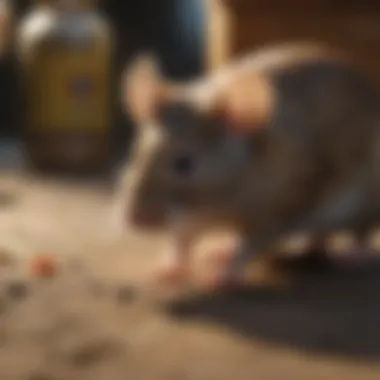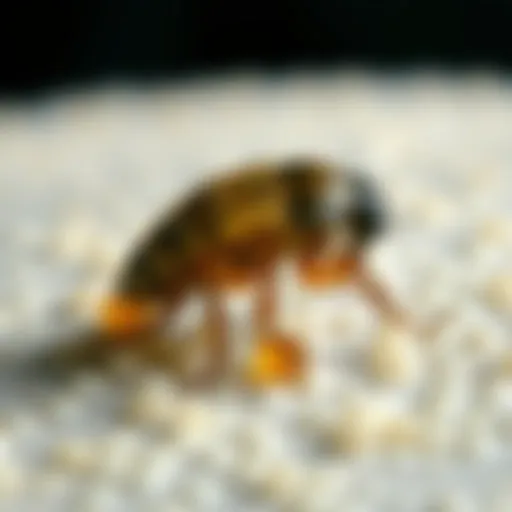Effective Mice Repellents: What Works and What Doesn't


Intro
In any household, the sighting of a mouse can trigger discomfort and concern. Understanding the dynamics of these pests is crucial for effective prevention and control. This article aims to dissect various mouse repellents available, investigating their scientific backing and practical applications. We will consider the behavioral traits of mice, evaluate various repellent strategies, and provide clear guidance for homeowners.
Understanding Pests
Definition of Pests
Pests are organisms that can cause harm to crops, livestock, and human dwellings. They often compete with humans for food and resources, leading to significant economic losses and health risks. Mice fit this definition as they invade homes in search of shelter and food. A single mouse can quickly transform into a larger infestation if not addressed promptly.
Importance of Pest Identification
Identifying the specific type of pest is fundamental to effective control actions. Understanding a mouse's behavior and habits helps in selecting the most appropriate repellent method. For instance, knowing that mice are nocturnal may lead homeowners to set traps during the night, when the rodents are most active. Recognizing signs of infestation, such as droppings or gnaw marks, is also essential for timely intervention.
Prevention Techniques
Home and Garden Preventative Measures
Preventing mice from entering your home is often the most effective approach. Here are several strategies:
- Seal Entry Points: Inspect the foundation, walls, and roofs for cracks or gaps. Filling these openings can reduce entries.
- Maintain Cleanliness: Store food in airtight containers and keep food preparation areas tidy. Mice are attracted to leftovers and crumbs.
- Proper Waste Management: Ensure trash cans are tightly closed and dispose of waste regularly.
Seasonal Prevention Tips
Seasonal factors can influence mouse activity. During colder months, mice seek warmth and food within homes. Homeowners should consider:
- Clearing leaves and debris from around the house in fall to eliminate nesting sites.
- Ensuring attics and basements are well-insulated and properly sealed to deter intrusions.
Eco-Friendly Pest Control Solutions
Overview of Sustainable Practices
In today’s environmentally conscious society, many homeowners prefer sustainable pest control options. These methods minimize harmful chemical usage. Some effective strategies include:
- Using traps that capture mice without causing harm.
- Implementing a combination of exclusion methods and trapping efforts.
Natural Remedies and Their Effectiveness
Natural repellents can also serve as alternatives to toxic chemicals. Examples of commonly suggested natural solutions are:
- Peppermint Oil: Its strong scent can be off-putting to mice. Soaking cotton balls and placing them in suspected entry points may help repel these pests.
- Clove Oil: Similarly to peppermint oil, clove oil can be used to deter mice due to its strong aroma.
"Remember, while repellent methods might deter mice, keeping the home secure and clean is the most effective long-term strategy."
Understanding Mice Behavior
Understanding the behavior of mice is crucial for effective pest control. Mice are adaptable creatures, and their biological and ecological attributes significantly influence their interactions with their environment. A deep dive into their behavior can unveil insights that will inform more effective repellent strategies. This section will discuss their biology, habitat preferences, and feeding habits.
Biology of Mice
Mice belong to the family Muridae and possess certain biological traits that make them particularly adept at surviving, even in urban areas. Their small size, typically ranging from two to four inches in body length, allows them to infiltrate tiny crevices and gaps. Mice are nocturnal, which means they are primarily active at night. This behavior makes it essential for homeowners to understand the signs of their presence, such as droppings or gnaw marks, often discovered during morning inspections.
Moreover, mice have a rapid reproduction rate. A single female can produce up to ten litters per year, with each litter comprising six to eight pups. This exponential growth can quickly lead to infestations if not kept in check. The biological resilience and rapid lifecycle of mice highlight the importance of comprehensive pest control strategies tailored to their behavior.
Habitat Preferences
Mice have specific habitat requirements that they seek in their living environments. They favor areas that provide warmth, shelter, and a consistent food source. Typically, they thrive in environments that offer small, concealed spaces like attics, basements, and wall voids.
Mice prefer living in close proximity to humans as it allows easy access to food. Common sources include grains, fruits, and pet food —anything that's easily accessible. Identifying these preferences is essential for implementing effective deterrents.
Mice only need a space as small as a quarter to enter a home, making sealing cracks and crevices vital in preventative measures.
To counteract these habits, homeowners should maintain cleanliness by promptly cleaning up spills and securely storing food. Reducing clutter can also minimize potential nesting sites.
Feeding Habits
Mice are omnivorous and can eat a wide range of food items. Their diet predominantly consists of grains, seeds, and fruits, but they can adapt to less wholesome options, including human food. This adaptability aids their survival, especially in urban settings where natural food sources may be limited.
Mice tend to exhibit selective feeding behaviors. They often nibble on food items and then choose to consume them based on scent or taste. This makes it essential to inspect pantry areas regularly for signs of feeding.


In summary, meticulously understanding the biology, habitat preferences, and feeding habits of mice provides a critical foundation for preventing infestations. This knowledge allows homeowners to implement targeted strategies that not only repel mice but also reduce the likelihood of their return.
Defining Mice Repellents
Understanding the different types of mice repellents is crucial for anyone facing the challenge of unwanted rodent presence in their home. Mice can be persistent pests, and knowing how to choose the correct repellent can significantly affect the extent of any infestation. This section aims to delineate the various methods available for repelling mice, highlighting key attributes, benefits, and considerations associated with these strategies.
Chemical Vs. Natural Repellents
The debate between chemical and natural repellents is significant in pest control. Chemical repellents often contain strong synthetic substances designed to deter mice effectively. Products like Raid Mouse Repellent or Ortho Home Defense utilize specific chemicals that repel rodents through potent odors or taste deterrents. On the other hand, natural repellents, such as peppermint oil or vinegar mixtures, present a safer alternative for households with children or pets. While chemical solutions may offer immediate results, natural alternatives may take longer to show effectiveness but usually provide a safer environment.
Choosing between these options often comes down to personal preference and the environmental impact one wishes to consider.
Mechanisms of Action
To comprehend why certain repellents work better than others, it’s necessary to grasp their mechanisms of action. Chemical repellents typically function through olfactory cues. Mice possess highly developed senses of smell, and certain chemicals exploit this sensitivity. For example, products with naphthalene can create an unpleasant atmosphere for mice, making them reluctant to enter treated areas.
Conversely, natural repellents rely more on strong scents and tastes that mice find unattractive. Essential oils, such as eucalyptus and citronella, disrupt their natural behaviors, effectively steering them away. Understanding these mechanics can help homeowners select the right repellent for their situation.
Safety Considerations
When discussing repellents, safety cannot be overstated. Chemical repellents carry potential risks, particularly if misapplied or if pets and children are around. Many contain hazardous materials that can cause adverse health effects if ingested or inhaled. Therefore, homeowners should always read labels carefully and adhere to recommended usage guidelines.
In contrast, natural repellents tend to pose fewer health risks and can often be safely used in areas where children and pets play. Nevertheless, it is worth noting that some essential oils can still cause allergies or irritation, so caution should be exercised.
Ultimately, a keen understanding of repellent types, their actions, and their safety profiles empowers individuals to make informed decisions that enhance not only efficacy but also safety in their pest control efforts.
"Choosing the right mice repellent is about balance – effectiveness, safety, and environmental impact must be weighed against each other."
Adopting the right approach ensures that mice are kept at bay, ultimately contributing to a more pleasant and secure living space.
Synthetic Mice Repellents
Synthetic mice repellents are a crucial topic in pest control discussions. These repellents provide a range of options for homeowners looking to combat mouse infestations effectively. Understanding synthetic solutions is vital because they often target the specific needs of mice behavior and biology. These products can offer rapid results, making them appealing for immediate action.
Overview of Synthetic Solutions
Synthetic solutions can include a variety of chemicals designed to deter or keep mice away. These compounds work by affecting the mouse's sensory systems. For instance, many synthetic repellents contain substances that produce strong smells. These smells can mask the natural scents that mice rely on for navigation and feeding, driving them away from treated areas. When using synthetic products, it is important to consider their active ingredients and how they function.
Some common types include:
- Ultrasonic repellents: Utilize sound waves that are considered unpleasant to rodents but inaudible to humans.
- Chemical sprays and granules: Often based on peppermint oil or other strong-smelling substances, they create a barrier that mice might avoid.
- Baits mixed with toxins: These are potentially dangerous and require careful handling to avoid harm to pets or children.
Popular Products on the Market
The market for synthetic mice repellents is vast, with several notable products gaining popularity. Commonly discussed options include:
- Ortho Home Defense Insect Killer: This product not only targets insects but also helps deter mice.
- Victorpest Mouse Repellent Spray: Known for its blend of ingredients that appeal to homeowner needs.
- Hot Shot Bed Bug and Flea Killer: While primarily for insects, it may have some effectiveness in deterring rodents.
When purchasing a product, it is necessary to evaluate the package labelling for usage instructions, safety guidelines, and possibly environmental impacts. Additionally, many products can be found easily online, such as on platforms like reddit.com or facebook.com where users share experiences.
Effectiveness and Efficacy
The effectiveness of synthetic mice repellents varies. Some products may deliver immediate results, while others may require repeated applications to establish a lasting barrier against mice. Efficacy also depends on several factors including the severity of the infestation, the specific environment, and proper usage of the product.
Research suggests that while some synthetic repellents can deter mice, they do not eliminate the problem entirely. This means that homeowners should use these as part of a broader pest management strategy.
"Using synthetic repellents effectively requires continued monitoring and reapplication, especially in areas heavily trafficked by mice."
Ultimately, understanding the benefits and limitations of synthetic repellents will aid homeowners in making informed decisions. Whether you choose to rely solely on these methods or incorporate them into a more holistic pest management system is a matter of individual preference and necessity.
Natural Mice Repellents
Natural mice repellents are gaining attention for their effectiveness and safety. Unlike synthetic solutions, they often pose fewer risks to pets and humans. This is a significant consideration for families trying to maintain a healthy home environment while dealing with pest issues. Developing an understanding of natural repellents can empower homeowners to act against mice invasions more effectively while being conscious of their ecological impact. Natural solutions can also be cost-effective and easier to implement, which appeals to many house owners.
Essential Oils as Repellents
Essential oils are a popular natural solution for repelling mice. Some specific oils, such as peppermint, eucalyptus, and tea tree oil, contain compounds that can deter mice effectively. Peppermint oil is often touted for its strong scent, which many people find pleasant but is unpleasant for mice. To use essential oils, homeowners can mix a few drops with water and spray it in areas where mice are likely to enter, such as doorways or near food storage.
Another method is to soak cotton balls in essential oils and place them strategically around the house. However, it is important to refresh the cotton balls regularly to maintain their potency. The scientific backing for the effectiveness of essential oils largely comes from their scent, which overwhelms the mice's sensitive olfactory senses. Though essential oils are a beneficial option, results can vary based on the concentration and application method.


Herbs and Plants
Utilizing herbs and plants is another approach in natural mice control. Specific plants such as mint, lavender, and citronella are known for their repelling properties. Planting these herbs around the home can create a barrier that helps deter mice. An added benefit is that these plants can also enhance the aesthetic appeal of a garden, thus serving dual purposes.
Homeowners can also dry these herbs and create sachets to place in areas prone to mice activity. The scent emanating from these herbs can create an unfriendly environment for mice. It is essential to keep in mind that while these plants may aid in repelling, they should be part of a broader pest management strategy instead of singular reliance.
Homemade Solutions
Homemade solutions allow homeowners to create effective mice repellents using simple ingredients found in most households. One common method involves mixing equal parts of water and vinegar. The distinct smell of vinegar can drive mice away. Another solution can be made from a blend of hot pepper flakes or cayenne pepper mixed with water, as the spicy elements can be irritating to mice.
To create a repellent spray, simply combine these ingredients in a spray bottle and target areas where you notice rodent activity. However, it is advisable to test the solution on a small area first to avoid potential damage to surfaces.
"Natural solutions are not only safer but also more sustainable, allowing us to coexist with our environment responsibly."
Evaluating Effectiveness
Evaluating the effectiveness of mice repellents is crucial for homeowners facing rodent problems. Understanding which methods truly work can save time, money, and frustration. Evaluating effectiveness means looking at scientific research, user experiences, and comparing different approaches. This ensures that one can choose a repellent strategy that offers real results while minimizing risks or side effects.
In the context of pest control, relying on anecdotal experiences without rigorous evaluation can set high expectations and lead to disappointment. Therefore, analyzing the efficacy of various repellents is beneficial not only for effective pest management but also for discerning between facts and myths prevalent in the market.
Scientific Studies on Mice Repellents
Scientific research plays a pivotal role in understanding the efficacy of various mice repellents. Several studies have investigated the active components in synthetic and natural repellents to determine their effectiveness in deterring mice. For example, research published in peer-reviewed journals often measures mice's behavioral responses to different substances and compares their reactions against control groups.
Studies may demonstrate that certain essential oils, such as peppermint oil, can disrupt the olfactory senses of mice, leading to avoidance behaviors. Similarly, laboratory tests often validate the chemical mechanics in synthetic repellents, confirming how they repel rather than kill.
It is important for homeowners to recognize that not all claimed properties of these products are supported by scientific evidence. Before selecting a repellent, one should seek research-based information that evaluates the long-term effects and reliability of these products.
Case Studies and User Experiences
Real-world applications tell much about the success of mice repellents. Case studies and user experiences can offer invaluable insights. For example, a family might report that using a particular brand of natural repellent successfully reduced mouse sightings in their home after a few weeks, while another might note it proved ineffective within the same time frame.
Feedback on social media platforms like Reddit and Facebook often highlights variations in effectiveness due to factors like home environment, population density of mice, and even regional variations in mouse behavior. Engaging with other users can aid in understanding potential pitfalls or superior choices in repellent methods.
Homeowners should consider both positive and negative experiences shared by others. It is often the nuanced details in user narratives that reveal how various factors can affect a repellent's success.
Comparative Analysis of Methods
A comparative analysis involves systematically assessing different mice repellent approaches on multiple criteria. Effectiveness, longevity, safety, and ease of use must be considered. For instance, while synthetic repellents might show greater immediate efficacy, natural options could be safer for households with pets and children.
"Not all repellents are created equal. It's vital to understand their comparative strengths and weaknesses to make an informed decision."
Benefits of each method should be listed clearly:
- Synthetic Repellents:
- Natural Repellents:
- Quick action against established infestations.
- Often longer-lasting than natural alternatives.
- Typically safer for the environment and home health.
- Pleasant scents that may also act as air fresheners.
Through comparative analyses, homeowners can better evaluate the trade-offs and select methods that align with their specific needs and environmental concerns. This approach helps in making informed decisions rather than relying solely on marketing claims.
Common Misconceptions
The discourse surrounding mice repellents often comes with a host of misconceptions that can lead individuals down ineffective paths. This section aims to clarify these misunderstandings, highlighting the importance of grounding one's pest control strategies in factual knowledge. Recognizing misconceptions about repellent efficacy, safety, and limitations is crucial for homeowners.
Understanding these elements not only allows for better decision-making but also helps in setting realistic expectations when employing various products and methods.
Debunking Myths About Efficacy
A prevalent myth is that all repellents are equally effective across different environments. This is not true. The effectiveness of a repellent can vary significantly based on factors such as type, placement, and environmental conditions. For example, while some synthetic repellents may work well indoors, they may lose efficacy outdoors due to weather elements.
Another misconception is that natural solutions are always safe and harmless. While they tend to have fewer chemicals, some natural repellents can still pose health risks if misused or improperly applied. It is important for homeowners to research and choose appropriate products based on the specific needs of their situation.
"Not all mice repellents are created equal and understanding their distinct uses can lead to more successful pest control outcomes."
Lastly, there is a common belief that once repellents are applied, there is no need for follow-up. This is misleading, as the effectiveness of most repellents can diminish over time, requiring routine maintenance and reapplication to keep mice at bay.
Understanding Limitations


Every repellent has its limitations. For instance, chemical repellents may deter mice effectively but could also harm non-target wildlife or pets if not managed properly. It is essential to understand that these products should not be solely relied upon; a multifaceted approach is often necessary to achieve long-term success.
Some natural repellents may work well in small doses, but their overall effectiveness can vary based on their concentration and delivery method. Homeowners should also consider that factors such as property layout and existing rodent populations can profoundly affect the performance of these repellents.
Furthermore, many users overlook the role of environmental factors. For example, a strong scent can fade quickly in open, windy areas, reducing the deterrent effect. Similarly, using too many products simultaneously may confuse the mice rather than effectively repel them.
In summary, being aware of both the myths and limitations of various mice repellents allows homeowners to apply a smarter, more informed approach toward pest management. Through education and understanding, achieving a pest-free home becomes a more attainable goal.
Sustainable Practices
Sustainable practices in pest management are increasingly vital due to growing environmental concerns. These practices focus on methods that minimize ecological impact while effectively controlling pests, specifically mice in this instance. In a world where chemical use can harm the ecosystem, exploring sustainable approaches offers benefits not just for homeowners, but also for wildlife and future generations.
Adopting sustainable practices includes utilizing eco-friendly materials and methods. This focus aligns with broader trends in environmental conservation. Homeowners and housewives can greatly benefit from choosing solutions that are safe for their families and pets. Moreover, such practices often involve less risk of toxicity, as many conventional repellents come with hazardous side effects.
Key considerations when implementing sustainable methods for mice repellent include:
- Material Selection: Opting for biodegradable repellent solutions reduces waste and soil contamination.
- Long-term Effects: Sustainable methods often encourage natural predator populations which can help manage mouse populations over time.
- Health: Homemade or natural repellents can be safer for indoor environments, minimizing potential allergic reactions or health risks associated with chemical exposure.
Emphasizing sustainability in pest control not only aligns with environmental stewardship but also enhances personal health and well-being.
Implementation of these practices requires a thoughtful approach and a willingness to explore alternatives. Homeowners can embrace a variety of eco-friendly solutions, from natural compounds to behavioral strategies, to create an effective and safe pest management plan.
Eco-Friendly Solutions
Eco-friendly solutions encompass a range of natural approaches and materials that deter mice without harming the environment. Common methods include the use of essential oils, natural repellents like peppermint oils, and other organic substances. These substances create unpleasant environments for mice, making them less likely to invade.
- Essential Oils: These oils, such as peppermint and eucalyptus, are known for their strong scents. They can be diluted and sprayed in areas prone to mice activity. The aroma is typically unpleasant to rodents, causing them to steer clear.
- Natural Substances: Ingredients like cayenne pepper or vinegar can be effective when applied correctly. Sprinkling cayenne powder in mouse entry points or using vinegar-soaked cotton balls can deter mice from entering spaces.
- Physical Barriers: Keeping areas clean and sealed off can also be considered eco-friendly. Simple actions like sealing cracks in walls or keeping food secure can drastically minimize attractants.
Integrating Repellents into IPM Strategies
Integrated Pest Management (IPM) strategies are crucial for effective long-term control of mice. IPM focuses on understanding pest behavior to implement a combination of various pest control methods in a sustainable manner. By integrating repellents into IPM strategies, homeowners can achieve a holistic approach to controlling mice while minimizing environmental impact.
- Monitoring: Regularly checking for signs of mice ensures prompt action can be taken before an influx occurs. Observations help in applying repellents to areas where they are most needed.
- Combination of Methods: Using both natural and synthetic repellents can enhance effectiveness. This combination can address different behavioral patterns in mice.
- Behavioral Control: Understanding what attracts mice allows homeowners to make behavioral changes. Simple actions like proper food storage and waste management can significantly diminish the likelihood of mice infestation.
In summary, sustainable practices in repelling mice not only focus on effective control but also encompass a broader responsibility toward the environment. Government, communities, and individuals are all stakeholders in fostering these practices. By choosing eco-friendly solutions and utilizing IPM strategies, homeowners can effectively manage mouse populations while safeguarding the planet.
Practical Application
In the realm of pest control, particularly concerning mice, the practical application of repellents holds substantial significance. Understanding how to utilize these repellents effectively can drastically diminish the chances of infestations within homes. Households often confront the challenge of unwanted guests, and applying the correct approach can make all the difference. This segment emphasizes the necessity of practical measures, outlining how informed application can contribute to long-lasting solutions and preventive measures.
How to Apply Repellents Effectively
Applying mice repellents is not only about choosing the right product; it involves strategic placement and consistent usage. House owners should begin by identifying areas where mice are prevalent. These locations often include kitchens, garages, and basements. Once identified, the task is to ensure that the chosen repellent reaches these target areas effectively.
- Identify Entry Points: Closely inspect your home for gaps, cracks, or holes. Mice can enter through remarkably small openings. Effective application starts with addressing these vulnerabilities.
- Choose Your Repellent: Options range from natural substances like peppermint oil to synthetic solutions such as rodenticides. Select based on your comfort with chemicals and environmental considerations.
- Application Methods: For liquid repellents, soaking cotton balls and placing them in strategic locations can be effective. For granules or powders, distributing them around the perimeter of your home provides a barrier. Make sure to follow the manufacturer's instructions for dosage and placement.
- Maintain Consistency: Consistent application is key. It is advisable to refresh repellents regularly to maintain their efficacy. Different seasons may require alterations to your methods, adjusting for changes in mice behavior or activity.
Monitoring and Maintenance
Monitoring and maintenance cannot be overlooked when dealing with mice repellents. Regular checks will ensure that the repellents are working as intended and that no new infestations arise. This process also includes assessing signs of mice activity, which can be as subtle as droppings or gnaw marks.
- Regular Inspections: Conduct systematic inspections of your home every week or two, focusing on areas where you previously noted activity. This will help catch any early signs of mice returning.
- Evaluate Repellent Efficacy: Assess how well your chosen repellent is working. If you notice new droppings or sightings, it may be time to reconsider your choice or methodology.
- Consider Environmental Changes: Seasonal changes can affect mouse activity. For example, in colder months, mice may seek warmth indoors, necessitating a review of your applied repellent strategy.
- Adjust as Necessary: Don’t hesitate to switch products or methods if you feel your current approach isn't yielding results. The effectiveness of different repellents can vary greatly depending on specific circumstances.
"Regular monitoring and adaptive strategies are crucial for ensuring long-term success against mice infestations."
In summary, practical application of mice repellents requires a deliberate approach. Proper identification, effective application, and continuous monitoring significantly enhance the potential for achieving a mouse-free environment. Engaging in these practices not only aids in addressing current issues but also prevents future infestations from taking root.
End
The importance of this conclusion section lies in the synthesis of knowledge surrounding effective mice repellents. As explored throughout the article, understanding the characteristics and behavior of mice enables homeowners to choose appropriate repellents. The effectiveness of these repellents, whether synthetic or natural, varies significantly based on their composition, application methods, and the individual circumstances of an infestation.
Future Perspectives in Mice Repellent Research
Future research on mice repellents is essential for advancing pest control practices. As scientists examine new materials and methods, the potential for enhanced efficacy increases. For example, integration of nanotechnology in synthetic repellents could lead to longer-lasting formulations that remain effective over time. Moreover, exploring the interaction between different natural compounds could yield innovative and safer repellent options, reducing reliance on harmful chemicals.
Additionally, studies assessing the ecological impact of repellents are crucial. Understanding how these substances affect non-target species can lead to the development of more responsible pest management strategies. Homeowners should anticipate the emergence of environmentally friendly solutions as researchers focus on sustainability without sacrificing effectiveness.
Final Thoughts on Appropriate Solutions
In light of the information presented, it is vital for homeowners to approach the selection of mice repellents thoughtfully. One method may not suit all situations, so it is prudent to consider the specific context of the infestation. Factors such as the type of property, the extent of the problem, and any existing safety concerns should influence decisions.
To summarize:
- Evaluate each repellent based on its reported effectiveness.
- Consider both synthetic and natural options and their respective benefits.
- Stay informed about emerging research to make educated choices.
By synthesizing this information, homeowners can find effective, practical, and sustainable mice repellent solutions tailored to their needs.



